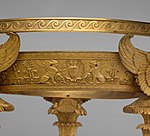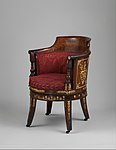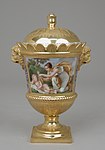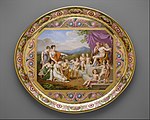Empire style
The Empire style (French pronunciation: [ɑ̃.piːʁ], style Empire) is an early-nineteenth-century design movement in architecture, furniture, other decorative arts, and the visual arts, representing the second phase of Neoclassicism. It flourished between 1800 and 1815 during the Consulate and the First French Empire periods, although its life span lasted until the late-1820s. From France it spread into much of Europe and the United States.[1]
The Empire style originated in and takes its name from the rule of the Emperor
History
Directoire style of the immediately preceding period, which aimed at a simpler, but still elegant evocation of the virtues of the
The Empire style "turned to the florid opulence of Imperial Rome. The abstemious severity of Doric was replaced by Corinthian richness and splendour".[3]
Two French architects,
Architecture of the Empire style was based on elements of the
The Empire period was popularized by the inventive designs of
General Bernadotte, later to become King
After Napoleon lost power, the Empire style continued to be in favour for many decades, with minor adaptations. There was a revival of the style in the last half of the nineteenth century in France, again at the beginning of the twentieth century, and again in the 1980s.
The style survived in Italy longer than in most of Europe, partly because of its Imperial Roman associations, partly because it was revived as a national style of architecture following the unification of Italy in 1870.
Motifs and ornaments
All Empire ornament is governed by a rigorous spirit of symmetry reminiscent of the
-
Detail of Arc de Triomphe du Carrousel from Paris, with a pair of winged Victories
-
A pair ofpalmettes, on a washstand (athénienne or lavabo)
-
A chair decorated with various kinds of palmettes
-
A table with three winged lions and a small long frieze with palmettes
Architecture
The most famous Empire-style structures in France are the grand neoclassical
Interiors have spacious rooms, richly decorated with symmetrically arranged motifs. The walls are decorated with Corinthian pilasters and vertical panels, having at the top a decorative frieze. The panels are covered with monumental paintings, stuccos, or with embroidered silks. The ceilings have light colours and fine ornaments.[6]
Historic sites which present an homogeneous ensemble, examples of the decoration of interiors of the early 19th century are:
- Château de Malmaison in France
- Hôtel de Beauharnaisin Paris
- Château de Compiègne in France
- Château de Fontainebleauin France
- Casa del Labrador in Spain
- Royal Palace of Amsterdam in The Netherlands
-
Empress Joséphine's Bedroom in Château de Malmaison (Rueil-Malmaison, France), 1800-1802, by Charles Percier and Pierre-François-Léonard Fontaine[7]
-
Arc de Triomphe du Carrousel (Paris), 1806-1808, by Charles Percier and Pierre-François-Léonard Fontaine[8]
Furniture
-
Washstand (athénienne or lavabo); 1800–1814; legs, base and shelf of yew wood, gilt-bronze mounts, iron plate beneath shelf; height: 92.4 cm, width: 49.5 cm; Metropolitan Museum of Art (New York City)
-
Secretary; c.1804-1809; amboyna wood veneered on pine, with gilt-bronze mounts; 173.4 x 87.6 x 37.8 cm; Metropolitan Museum of Art
-
Throne of Napoleon I; by Georges Jacob and François-Honoré-Georges Jacob-Desmalter; 1804; embroidered velvet, gilt wood and ivory; height: 1.2 m; Louvre[10]
-
Throne; byMusée des Arts Décoratifs (Paris)[12]
-
Desk chair; c.1805–1808; mahogany, gilt bronze and satin-velvet upholstery; 87.6 × 59.7 × 64.8 cm; Metropolitan Museum of Art
-
Jewelry holder of theEmpress Josephine; by François-Honoré-Georges Jacob-Desmalter; 1809; mahogany, amaranth, ebony, taxus, mother-of-pearl, and gilt bronze mounts; 2.76 x 2 x 0.6 m; Louvre[13]
-
Egyptian Revival coin cabinet; by François-Honoré-Georges Jacob-Desmalter; 1809–1819; mahogany (probably Swietenia mahagoni), with applied and inlaid silver; 90.2 x 50.2 x 37.5 cm; Metropolitan Museum of Art
-
Chair; before 1810; white trimmed wood with gilt carved decoration, modern trim, red and white silk; 90 x 50.5 x 44 cm; Louvre[14]
-
King of Rome's Cradle (Empire); bymother-of-pearl, sheets of copper covered with velvet, silk and tulle, decorated with silver and gold thread; height: 216 cm; Kunsthistorisches Museum (Vienna, Austria)[15]
Clocks and candelabrums
-
Candelabrum; circa 1800; gilt and patinated metal; overall: 49.9 x 25.7 x 12.3 cm; Cleveland Museum of Art (Cleveland, Ohio, US)
-
Egyptian Revival vase with pedestal; 1804-1806; varnished sheet and gilded bronze; height: 1.80 m, depth: 0.95 m; Louvre[16]
-
Musée des Arts Décoratifs (Paris)[17]
-
Clock; 1807-1810; fire-gilt bronze, blackened bronze, enameled metal (dial), blued steel (hands); glass; 56 x 49.7 x 18.5 cm; Cooper Hewitt, Smithsonian Design Museum (New York City)
-
Centerpiece between two candelabra; by Pierre-Philippe Thomire; circa 1810; probably gilded bronze;Lisboa, Portugal)
-
Pair of candelabra with Winged Victories; 1810–1815; gilt bronze; height (each): 127.6 cm; Metropolitan Museum of Art (New York City)
-
Mantel clock called The Reader; by Jean-Andre Reiche; circa 1810; matte and polished gilt bronze and "Vert de Mer" marble; 31 x 15 x 26 cm; Montreal Museum of Fine Arts (Montreal, Canada)[18]
Ceramic
-
Teapot (théière Asselin), part of a breakfast service (déjeuner); 1813; hard-paste porcelain; height (with handle): 20.5 cm; Metropolitan Museum of Art (New York City)
-
Saucer, part of a breakfast service (déjeuner); 1813; hard-paste porcelain; height: 3.2 cm; diameter: 16.2 cm; Metropolitan Museum of Art
-
Sugar bowl with cover, part of a breakfast service (déjeuner); 1813; hard-paste porcelain; height: 21 cm; Metropolitan Museum of Art
-
Milk jug (pot à lait Étrusque), part of a breakfast service (déjeuner); 1813; hard-paste porcelain; height (with handle): 21.3 cm; Metropolitan Museum of Art
-
Tray (plateau), part of a breakfast service (déjeuner); 1813; hard-paste porcelain; 2.5 x 37.5 x 33.3 cm; Metropolitan Museum of Art
-
Cup (tasse Jasmin), part of a breakfast service (déjeuner); 1813; hard-paste porcelain and silver gilt; height: 11.3 cm; Metropolitan Museum of Art
Fashion
-
Portrait of Madame Charles Maurice de Talleyrand Périgord, from circa 1804
-
1809 illustration which shows how male Empire fashion looks like, from Journal des dames et des modes
-
Portrait of Charles Maurice de Talleyrand Périgord, from 1817
See also
- American Empire style
- Chariot clock
- Empire silhouette
- French Empire mantel clock
- Indies Empire style
- Lighthouse clock
- Lyre arm
- Neoclassicism in France
- Neoclassical architecture in Milan
- Neo-Grec, the late Greek revival style architecture
- Palace of Fontainebleau
- Second Empire (architecture)
References
- ^ Gontar, Cybele (1 October 2004). "Empire Style, 1800–1815". metmuseum.org. Department of European Sculpture and Decorative Arts, The Metropolitan Museum of Art. Retrieved 18 September 2022.
Courts across Europe adopted the Empire style, especially in Russia, where it became a staple. In Germany and Austria, it coexisted with the gentler Biedermeier associated with modest domestic interiors. Charles Percier (1764–1838) and Pierre François Léonard Fontaine (1762–1853) were the two most influential figures in the field of Empire decoration and furnishing. Official architects to the court of Napoleon, their main responsibility was the renovation of the various royal residences. Their Recueil de décorations intérieures (1812) was an essential handbook of the Empire style.
- ^ (Honour 1977, p. 171)
- ^ Honour 1977, p. 172
- OCLC 234047178.
- ^ Sylvie, Chadenet (2001). French Furniture • From Louis XIII to Art Deco. Little, Brown and Company. p. 103 & 105.
- ^ Ecaterina Oproiu, Tatiana Corvin (1975). Enciclopedia căminului (in Romanian). Editura științifică și enciclopedică. p. 44 & 45.
- ^ Jones 2014, p. 275.
- ^ a b c Hopkins 2014, p. 111.
- ^ Hopkins 2014, p. 112.
- ^ "Fauteuil du trône de Napoléon Ier aux Tuileries". collections.louvre.fr. Retrieved 23 May 2022.
- ^ "Commode à deux vantaux". collections.louvre.fr. Retrieved 23 May 2022.
- ISBN 978-0-8109-9345-7.
- ^ "Serre-bijoux de l'Impératrice Joséphine, dit Grand écrin". collections.louvre.fr. Retrieved 23 May 2022.
- ^ "Deux chaises". collections.louvre.fr. Retrieved 23 May 2022.
- ISBN 978-0-8109-9345-7.
- ^ Muriel Barbier. "Egyptian vase and pedestal". louvre.fr. Retrieved 12 March 2021.
- ISBN 978-0-8109-9345-7.
- ^ "MANTEL CLOCK "LA LISEUSE"". www.kollerauktionen.ch.
- OCLC 36284165.
- Hopkins, Owen (2014). Architectural Styles: A Visual Guide. Laurence King. ISBN 978-178067-163-5.
- Jones, Denna, ed. (2014). Architecture The Whole Story. Thames & Hudson. ISBN 978-0-500-29148-1.
External links
![]() Media related to Empire style at Wikimedia Commons
Media related to Empire style at Wikimedia Commons






![Empress Joséphine's Bedroom in Château de Malmaison (Rueil-Malmaison, France), 1800-1802, by Charles Percier and Pierre-François-Léonard Fontaine[7]](http://upload.wikimedia.org/wikipedia/commons/thumb/e/e1/Ch%C3%A2teau_de_Malmaison%2C_France_%2848029730202%29.jpg/150px-Ch%C3%A2teau_de_Malmaison%2C_France_%2848029730202%29.jpg)
![Arc de Triomphe du Carrousel (Paris), 1806-1808, by Charles Percier and Pierre-François-Léonard Fontaine[8]](http://upload.wikimedia.org/wikipedia/commons/thumb/7/77/Paris_-_Jardin_des_Tuileries_-_Arc_de_Triomphe_du_Carrousel_-_PA00085992_-_003.jpg/150px-Paris_-_Jardin_des_Tuileries_-_Arc_de_Triomphe_du_Carrousel_-_PA00085992_-_003.jpg)
![Portico of the Palais Bourbon (Paris), 1806-1808, by Bernard Poyet[8]](http://upload.wikimedia.org/wikipedia/commons/thumb/9/9c/Palais_Bourbon%2C_Paris_7e%2C_NW_View_140402_1.jpg/150px-Palais_Bourbon%2C_Paris_7e%2C_NW_View_140402_1.jpg)
![Vendôme Column (Place Vendôme, Paris), 1806-1810, by Jacques Gondouin and Jean-Baptiste Lepère[9]](http://upload.wikimedia.org/wikipedia/commons/thumb/e/e2/P1040409_Paris_Ier_colonne_Vend%C3%B4me_rwk.JPG/115px-P1040409_Paris_Ier_colonne_Vend%C3%B4me_rwk.JPG)
![La Madeleine (Paris), 1807-1842, by Pierre-Alexandre Vignon [fr][8]](http://upload.wikimedia.org/wikipedia/commons/thumb/3/3a/Madeleine_Paris.jpg/150px-Madeleine_Paris.jpg)



![Throne of Napoleon I; by Georges Jacob and François-Honoré-Georges Jacob-Desmalter; 1804; embroidered velvet, gilt wood and ivory; height: 1.2 m; Louvre[10]](http://upload.wikimedia.org/wikipedia/commons/thumb/6/6b/Le_Tr%C3%B4ne_de_Napol%C3%A9on_Ier_aux_Tuileries_-_Mus%C3%A9e_du_Louvre_Objets_d%27art_GMTC_2.jpg/138px-Le_Tr%C3%B4ne_de_Napol%C3%A9on_Ier_aux_Tuileries_-_Mus%C3%A9e_du_Louvre_Objets_d%27art_GMTC_2.jpg)
![Commode with two door panels; before 1805; mahogany with bronze mounts; 1.165 x 1.794 x 0.83 m; Louvre[11]](http://upload.wikimedia.org/wikipedia/commons/thumb/d/d1/Commode_with_Two_Door_Panels_-_OA_9968_-_Louvre_%2801%29.jpg/150px-Commode_with_Two_Door_Panels_-_OA_9968_-_Louvre_%2801%29.jpg)
![Throne; by Bernard Poyet and François-Honoré-Georges Jacob-Desmalter; 1805; carved and gilded wood, covered in red velvet with silver embroidery; 160 x 110 x 82 cm; Musée des Arts Décoratifs (Paris)[12]](http://upload.wikimedia.org/wikipedia/commons/thumb/1/1a/Tr%C3%B4ne_de_Napol%C3%A9on_1er_en_provenance_du_Corps_l%C3%A9gislatif_-_Exposition_Versailles.jpg/99px-Tr%C3%B4ne_de_Napol%C3%A9on_1er_en_provenance_du_Corps_l%C3%A9gislatif_-_Exposition_Versailles.jpg)

![Jewelry holder of the Empress Josephine; by François-Honoré-Georges Jacob-Desmalter; 1809; mahogany, amaranth, ebony, taxus, mother-of-pearl, and gilt bronze mounts; 2.76 x 2 x 0.6 m; Louvre[13]](http://upload.wikimedia.org/wikipedia/commons/thumb/9/92/Serre-bijoux_de_l%27Imp%C3%A9ratrice_dit_Grand_%C3%A9crin_%28Louvre%2C_OA_10246%29.jpg/112px-Serre-bijoux_de_l%27Imp%C3%A9ratrice_dit_Grand_%C3%A9crin_%28Louvre%2C_OA_10246%29.jpg)

![Chair; before 1810; white trimmed wood with gilt carved decoration, modern trim, red and white silk; 90 x 50.5 x 44 cm; Louvre[14]](http://upload.wikimedia.org/wikipedia/commons/thumb/a/ab/Empire_chair_Louvre_OA11934.jpg/99px-Empire_chair_Louvre_OA11934.jpg)
![King of Rome's Cradle (Empire); by Pierre-Paul Prud'hon, Henri-Victor Roguier [fr], Jean-Baptiste-Claude Odiot and Pierre-Philippe Thomire; 1811; wood, silver gilt, mother-of-pearl, sheets of copper covered with velvet, silk and tulle, decorated with silver and gold thread; height: 216 cm; Kunsthistorisches Museum (Vienna, Austria)[15]](http://upload.wikimedia.org/wikipedia/commons/thumb/b/b0/Austria-03324_-_Cradle_of_Napoleon%27s_Son_%2832936041295%29.jpg/100px-Austria-03324_-_Cradle_of_Napoleon%27s_Son_%2832936041295%29.jpg)

![Egyptian Revival vase with pedestal; 1804-1806; varnished sheet and gilded bronze; height: 1.80 m, depth: 0.95 m; Louvre[16]](http://upload.wikimedia.org/wikipedia/commons/thumb/a/a5/Vase_%C3%A9gyptien_%28Louvre%2C_LP_3275%29.jpg/69px-Vase_%C3%A9gyptien_%28Louvre%2C_LP_3275%29.jpg)
![Minerva candelabra; 1804-1814; gilded and patinated bronze; height: 101 cm, width of the plinth: 25 cm, depth of the plinth: 19 cm; Musée des Arts Décoratifs (Paris)[17]](http://upload.wikimedia.org/wikipedia/commons/thumb/5/53/Minerve%2C_cand%C3%A9labre.jpg/75px-Minerve%2C_cand%C3%A9labre.jpg)




![Mantel clock called The Reader; by Jean-Andre Reiche; circa 1810; matte and polished gilt bronze and "Vert de Mer" marble; 31 x 15 x 26 cm; Montreal Museum of Fine Arts (Montreal, Canada)[18]](http://upload.wikimedia.org/wikipedia/commons/thumb/a/a3/Mantel_clock_called_The_Reader%2C_by_Jean-Andre_Reiche%2C_active_in_Paris%2C_1752-1817%2C_gilt_bronze%2C_chased_and_patinated%2C_marble%2C_enamel_-_Montreal_Museum_of_Fine_Arts_-_Montreal%2C_Canada_-_DSC08693.jpg/127px-thumbnail.jpg)









